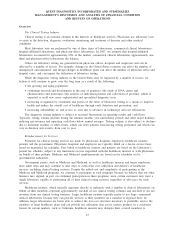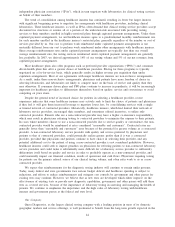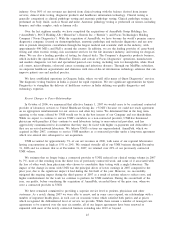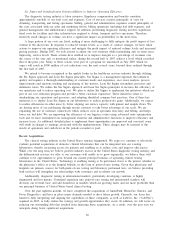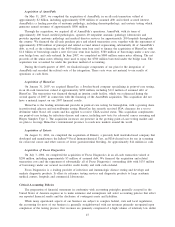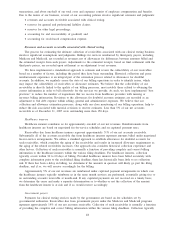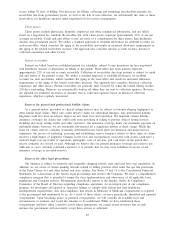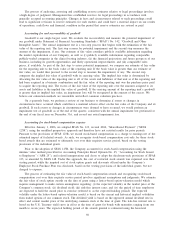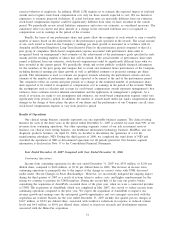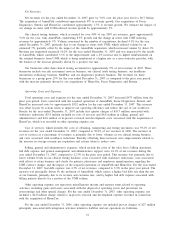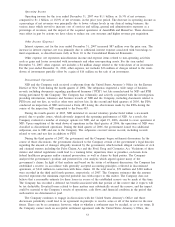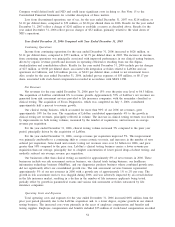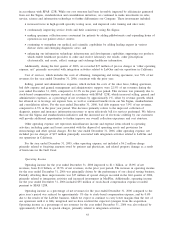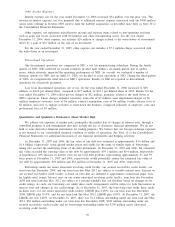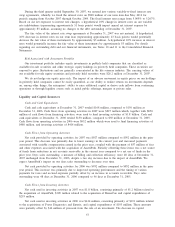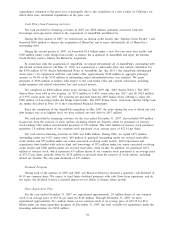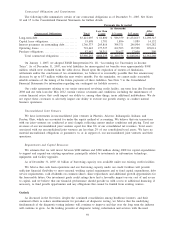Quest Diagnostics 2007 Annual Report Download - page 60
Download and view the complete annual report
Please find page 60 of the 2007 Quest Diagnostics annual report below. You can navigate through the pages in the report by either clicking on the pages listed below, or by using the keyword search tool below to find specific information within the annual report.exercise behavior of employees. In addition, SFAS 123R requires us to estimate the expected impact of forfeited
awards and recognize stock-based compensation cost only for those awards expected to vest. We use historical
experience to estimate projected forfeitures. If actual forfeiture rates are materially different from our estimates,
stock-based compensation expense could be significantly different from what we have recorded in the current
period. We periodically review actual forfeiture experience and revise our estimates, as considered necessary. The
cumulative effect on current and prior periods of a change in the estimated forfeiture rate is recognized as
compensation cost in earnings in the period of the revision.
Finally, the terms of our performance share unit grants allow the recipients of such awards to earn a variable
number of shares based on the achievement of the performance goals specified in the awards. The actual amount
of any stock award is based on the Company’s earnings per share growth as measured in accordance with its
Amended and Restated Employee Long-Term Incentive Plan for the performance period compared to that of a
peer group of companies. Stock-based compensation expense associated with performance share units is
recognized based on management’s best estimates of the achievement of the performance goals specified in such
awards and the resulting number of shares that will be earned. If the actual number of performance share units
earned is different from our estimates, stock-based compensation could be significantly different from what we
have recorded in the current period. We periodically obtain and review publicly available financial information
for the members of the peer group and compare that to actual and estimated future performance of the Company,
including historical earnings per share growth as well as published estimates of projected earnings per share
growth. This information is used to evaluate our progress towards achieving the performance criteria and our
estimate of the number of performance share units expected to be earned at the end of the performance period.
The cumulative effect on current and prior periods of a change in the estimated number of performance share
units expected to be earned is recognized as compensation cost in earnings in the period of the revision. While
the assumptions used to calculate and account for stock-based compensation awards represent management’s best
estimates, these estimates involve inherent uncertainties and the application of management’s judgment. As a
result, if revisions are made to our assumptions and estimates, our stock-based compensation expense could vary
significantly from period to period. In addition, the number of awards made under our equity compensation plans,
changes in the design of those plans, the price of our shares and the performance of our Company can all cause
stock-based compensation expense to vary from period to period.
Results of Operations
Our clinical testing business currently represents our one reportable business segment. The clinical testing
business for each of the three years in the period ended December 31, 2007 accounted for more than 90% of net
revenues from continuing operations. Our other operating segments consist of our risk assessment services
business, our clinical trials testing business, our healthcare information technology business, MedPlus, and our
diagnostic products business. On April 19, 2006, we decided to discontinue the operations of a test kit
manufacturing subsidiary, NID. During the third quarter of 2006, we completed the wind down of NID and
classified the operations of NID as discontinued operations for all periods presented. Our business segment
information is disclosed in Note 17 to the Consolidated Financial Statements.
Year Ended December 31, 2007 Compared with Year Ended December 31, 2006
Continuing Operations
Income from continuing operations for the year ended December 31, 2007 was $554 million, or $2.84 per
diluted share, compared to $626 million, or $3.14 per diluted share in 2006. The decrease in income from
continuing operations is principally due to the impact of the change in contract status with UNH, discussed
earlier under “Recent Changes in Payer Relationships”. However, we successfully mitigated the ongoing impact
during the third quarter of 2007 as a result of actions taken to reduce costs, and higher reimbursement for the
testing we continue to perform for UNH members. During the second half of the year our profits, before
considering the acquisition of AmeriPath, exceeded those of the prior year, when we were a contracted provider
to UNH. The acquisition of AmeriPath, which was completed in May 2007, also served to reduce income from
continuing operations compared to the prior year. We expect the acquisition of AmeriPath to improve our
revenue growth and earnings once the anticipated growth opportunities and cost synergies associated with the
acquisition are realized. Results for the year ended December 31, 2007 include first quarter pre-tax charges of
$10.7 million, or $0.03 per diluted share, associated with workforce reductions in response to reduced volume
levels and $4.0 million, or $0.01 per diluted share, related to in-process research and development expense
associated with the HemoCue acquisition.
51




